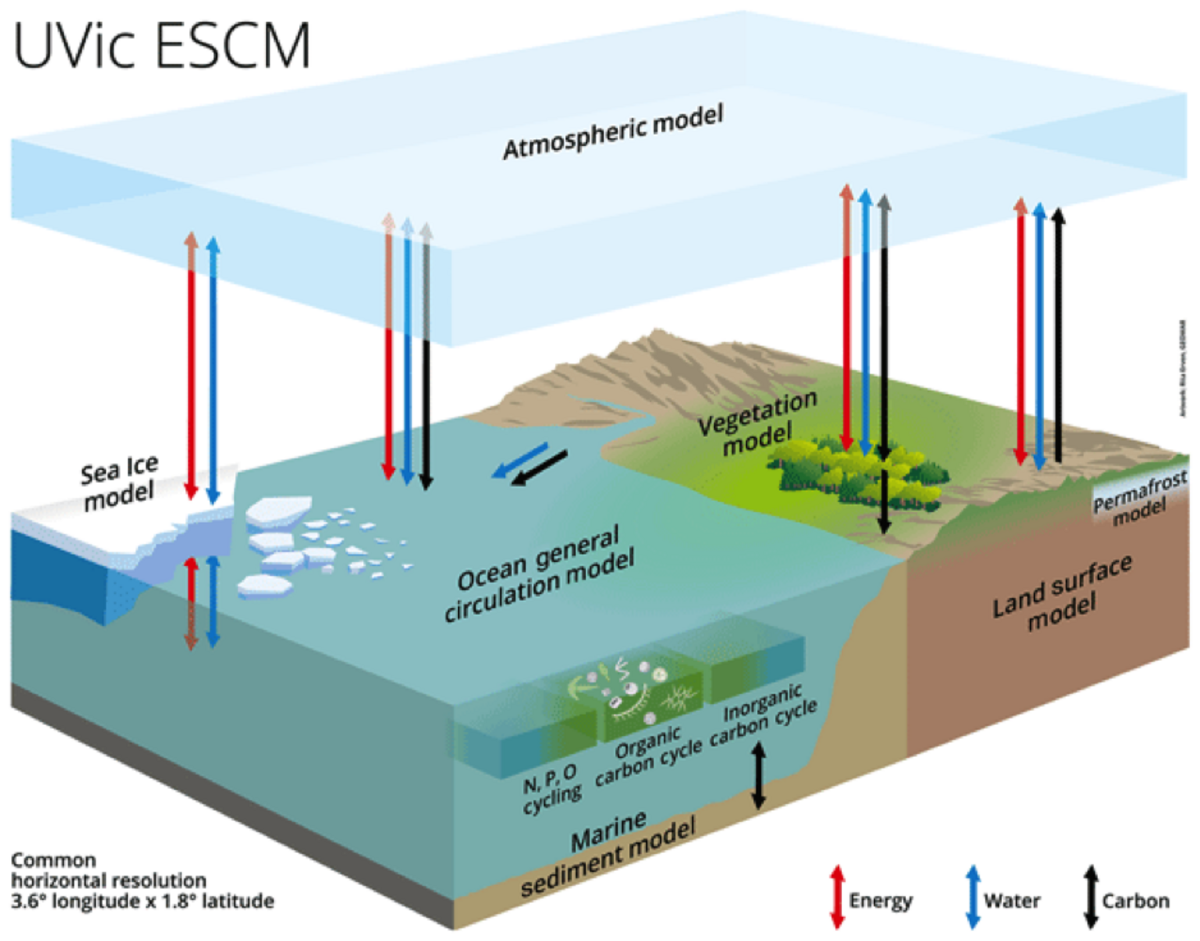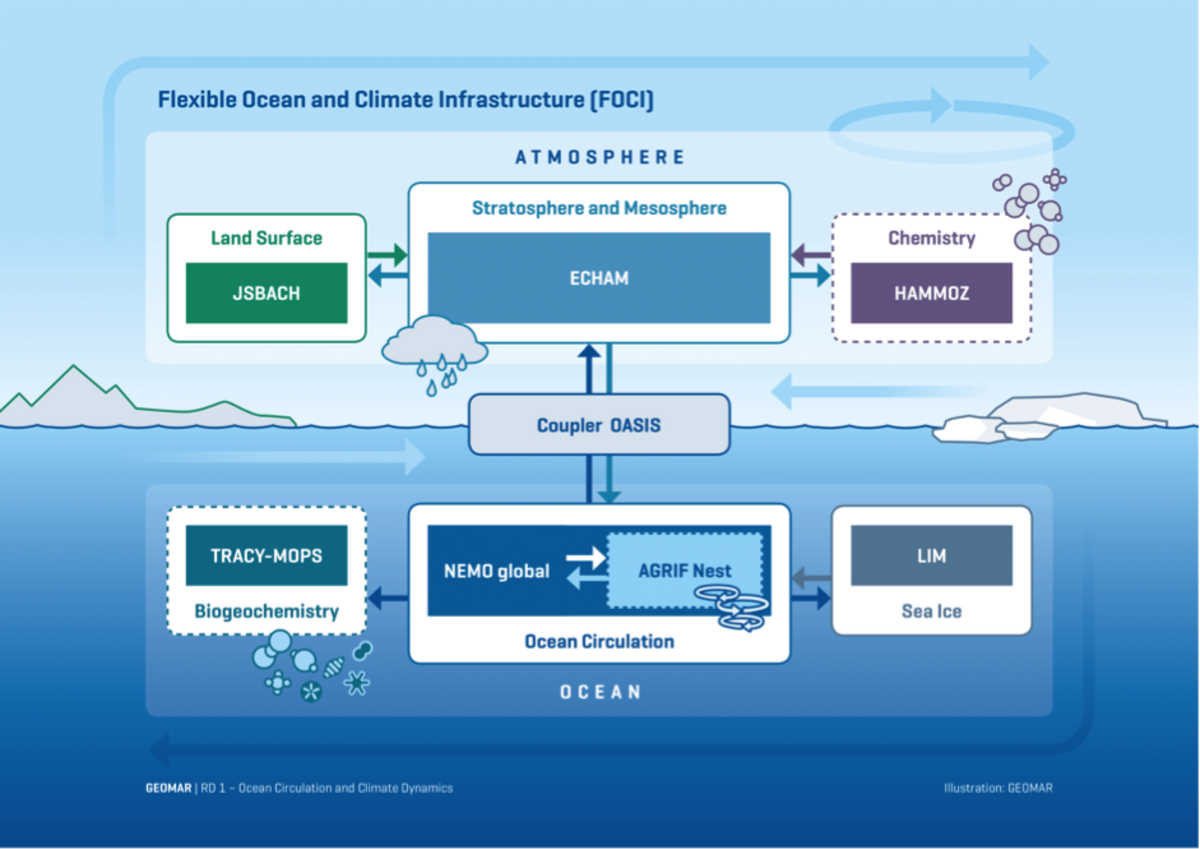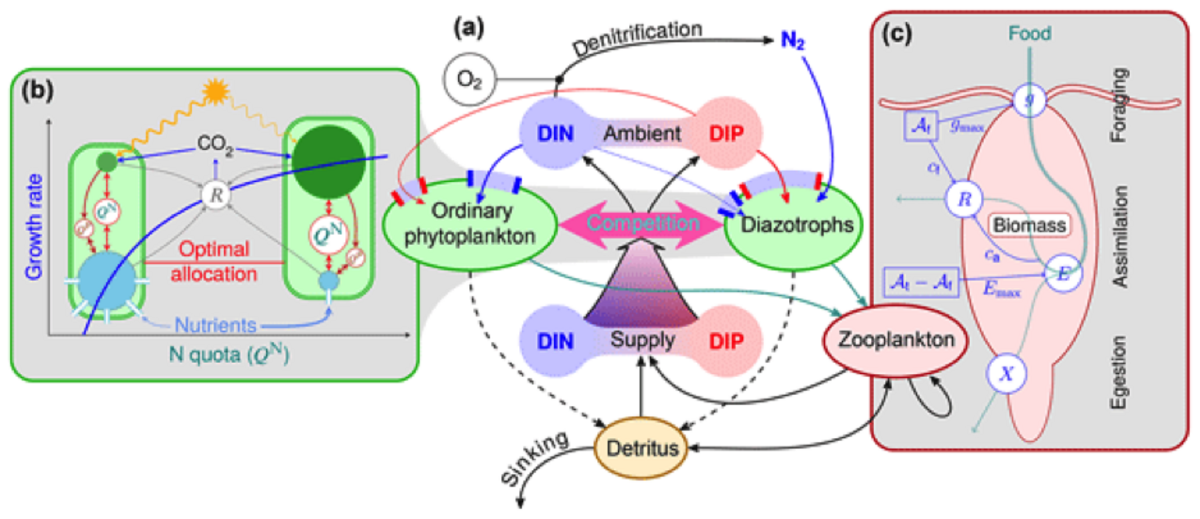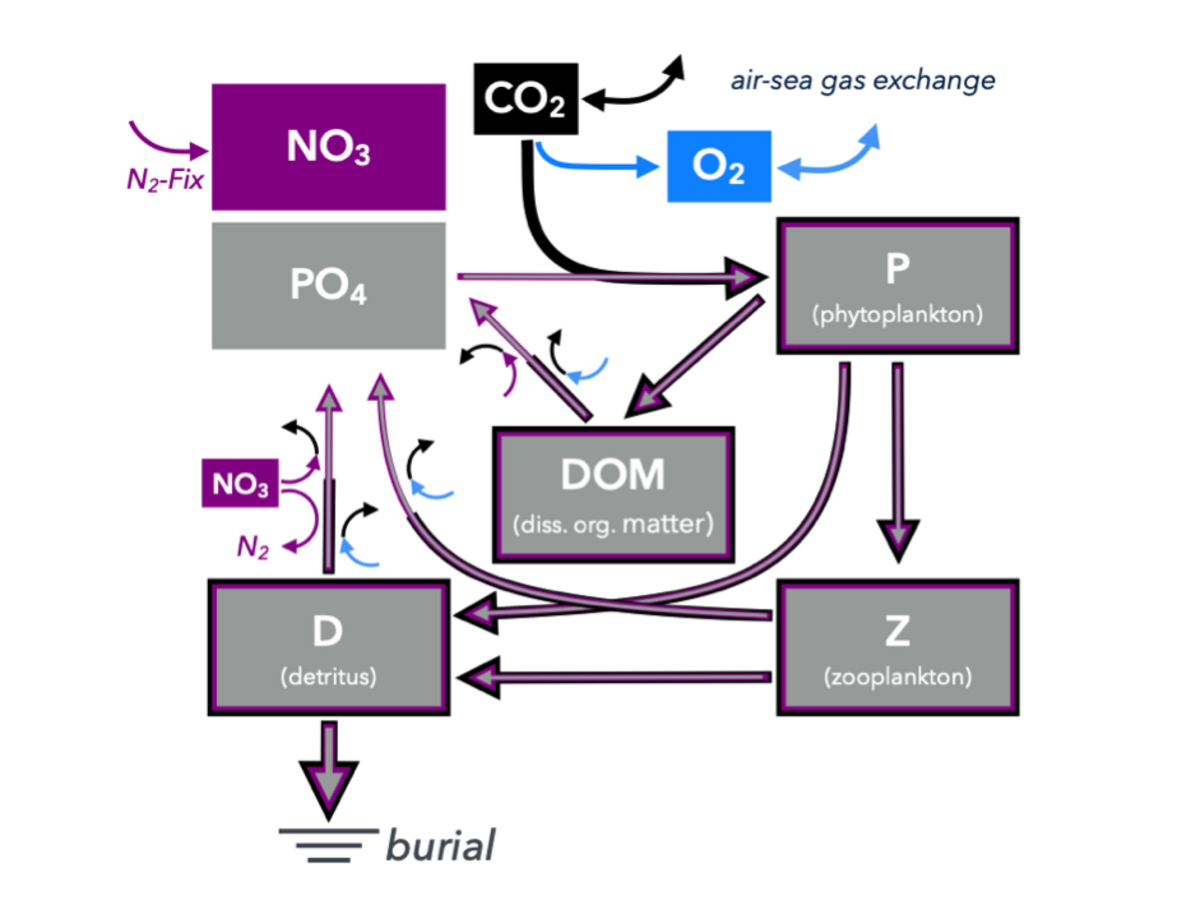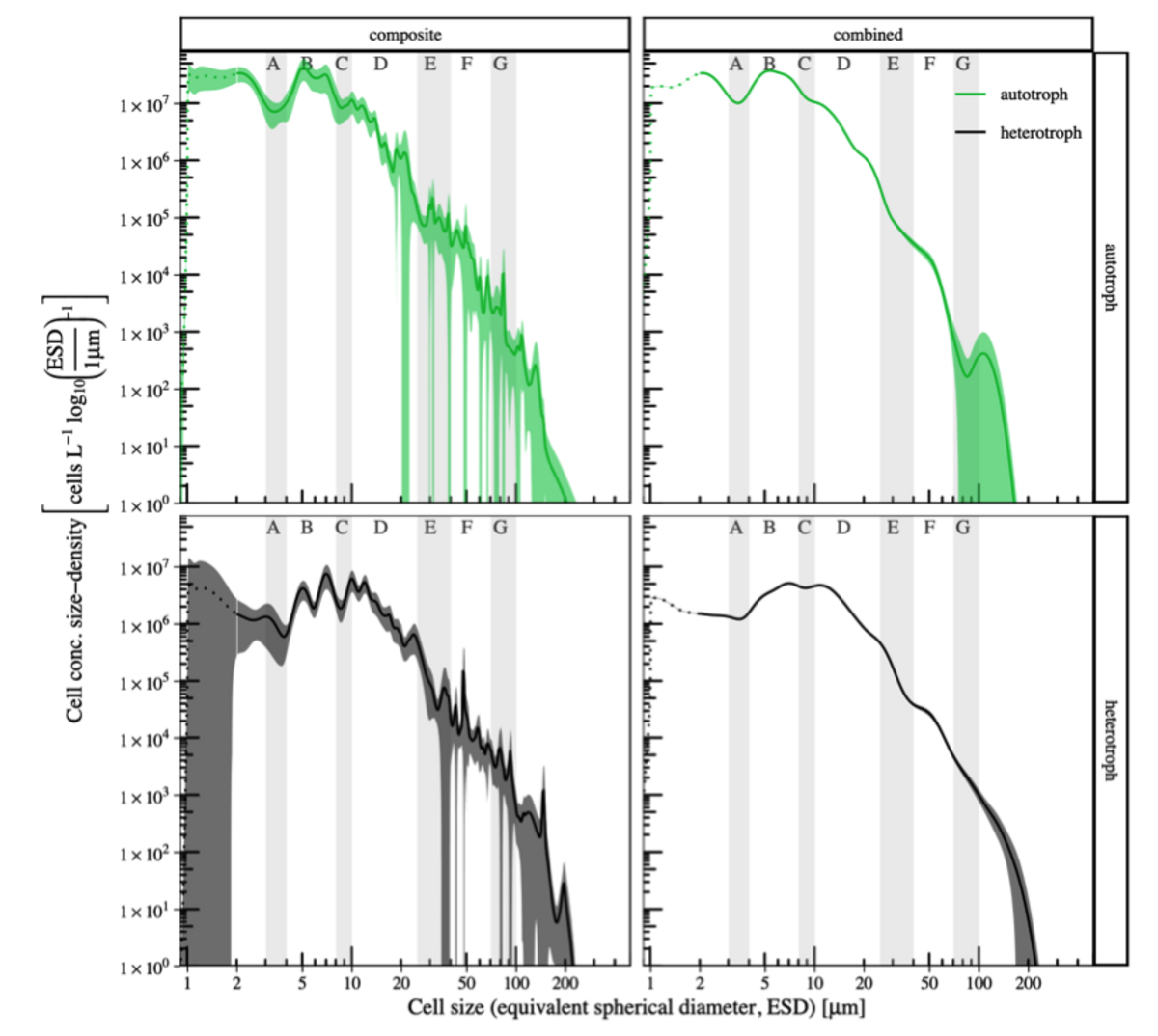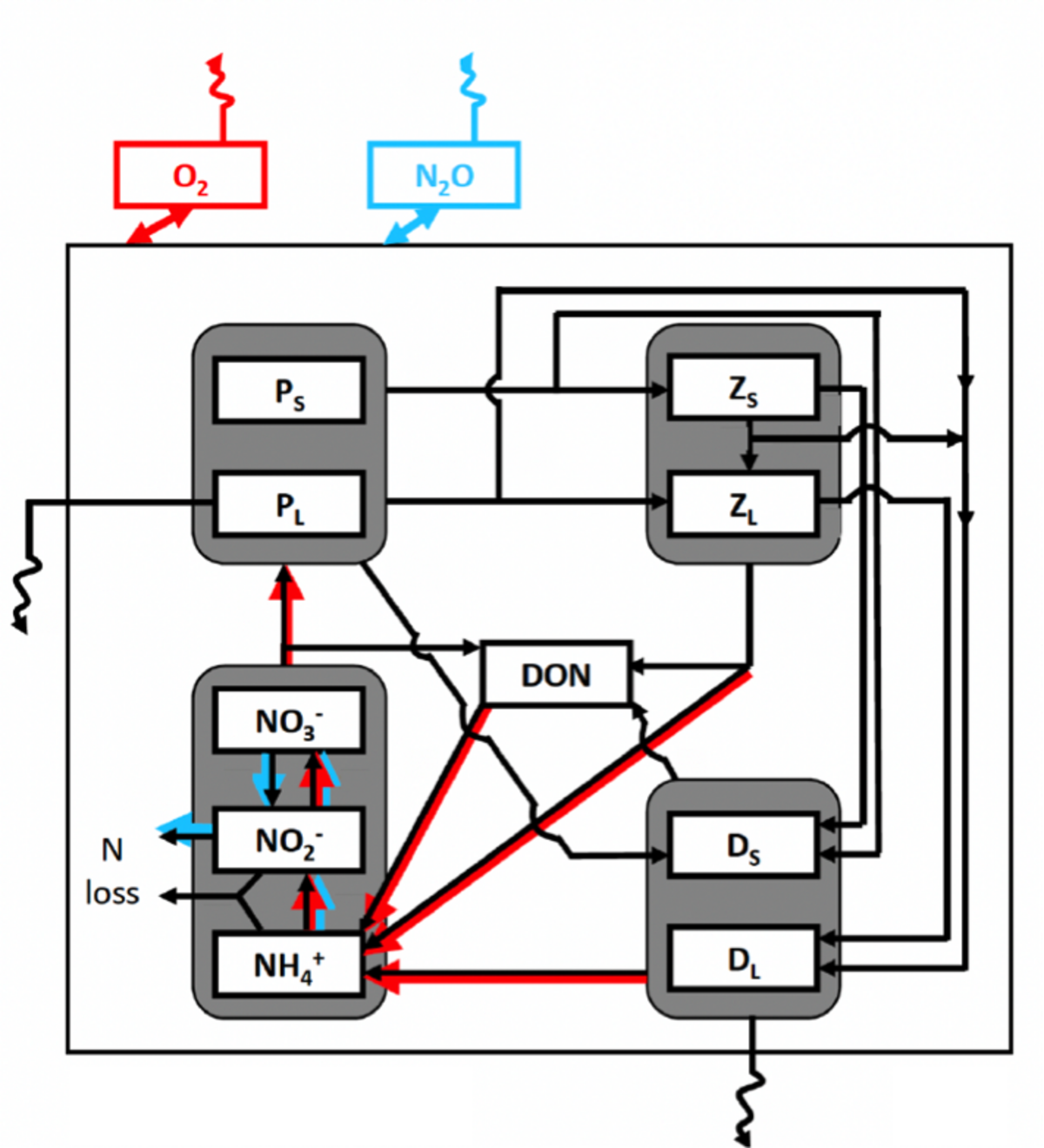Our team is dedicated to advance our understanding of the complex biogeochemical interactions between the Earth's climate and its various components through the use of a wide variety of modeling techniques. We specialize in biogeochemical modeling and work with several tools for ocean biogeochemical simulations.
Our group is composed of interdisciplinary researchers, including climate scientists, oceanographers, ecologists, and computer scientists, who collaborate to develop and improve these biogeochemical modeling tools. We use a range of observational data, such as satellite data and oceanic measurements, to validate and improve the accuracy of our models.
The UVic Earth System Climate Model is a comprehensive tool that simulates the interactions between the Earth's atmosphere, oceans, land, and cryosphere. Within the model, we focus on the biogeochemical cycling of elements such as carbon, nitrogen, and phosphorus. We use this model to understand the past, present, and future biogeochemical conditions of the Earth, and to investigate the impacts of different climate change scenarios on these cycles. We use the UVic-ESCM in a variety of clones, prepared for different purposes (contacts: Nadine Mengis (UVic 2.10), Wolfgang Koeve (UVic 2.9-BCPtracers), Andreas Oschlies (UVic 2.8), Markus Pahlow (UVic-OPEM), Chris Somes (UVic-Isotopes), David Keller (UVic-ClimateEngineering).
The FOCI (Flexible Ocean and Climate Infrastructure) model is a flexible infrastructure for simulating the behavior of the ocean and its interactions with the atmosphere. This model is designed to be highly flexible and adaptable, allowing us to study biogeochemical processes on a variety of scales, from small regions to the entire global ocean. This scalability makes FOCI a useful tool for studying regional as well as large scale oceanic processes. We use FOCI as a tool to investigate the potential for carbon dioxide removal (CDR) from the atmosphere, e.g. limestone injection and its effect on the biogeochemical cycling of elements in the North Atlantic. (contact: Tronje Kemena)
The Optimality-Based Non-Redfield Plankton-Ecosystem Model is a unique biogeochemical modeling tool that simulates the behavior of marine organisms and their interactions with the environment. This model incorporates the principle of ecological optimization to predict the behavior of marine organisms in response to changing environmental conditions. We use this model to study the biogeochemical cycling of elements such as carbon, nitrogen, and phosphorus within marine ecosystems. (contact: Markus Pahlow)
We also use the Transport Matrix Method (TMM; see https://github.com/samarkhatiwala/tmm) for biogeochemical simulations at the global scale. The TMM is a numerical technique to simulate the transport of passive tracers, such as nutrients, through the ocean, and is based on Transport Matrices (TMs), that capture the three-dimensional transport of tracers in a general circulation model as sparse matrices, thereby relieving the user from the computational burden of running a full circulation model. One application of this computationally efficient tool is the calibration of the biogeochemical model MOPS against observations of biogeochemical tracers at a global scale, using derivative-free optimisation methods such as CMA-ES (see below).
MOPS (Model of Oceanic Pelagic Stoichiometry) is an biogeochemical model of intermediate complexity that parameterises a range of physiological and ecological processes to simulate the interactions of organic marine components (among them plankton), the overall focus being on the coupling of the phosphorus, nitrogen and oxygen cycle. This model facilitates the mechanistic understanding of the factors influencing the large-scale distribution of different biogeochemical tracers; at the same time it aims to maintain computational efficiency for incorporation into Earth system models (e.g., FOCI; see above). (contact: Iris Kriest)
Kernel Density Estimation (KDE) is a statistical technique used to estimate the probability density function of a random variable. In our research group, we use KDE to derive continuous plankton size spectra from observational data. Traditionally, plankton size spectra have been described as histograms with specified size classes, which can mask structural details and may impede analyses and comparisons between spectra. KDE offers a more continuous and flexible approach to estimating size spectra, allowing us to better capture the underlying variability in the data, e.g. as applied by Vanessa Lampe with microscopic counts from Eva-Maria Nöthig at the Alfred Wegener Institute (AWI) Bremerhaven. Most recent analyses consider applications of a diffusion KDE, improved by Maria-Theresia Pelz in collaboration with Thomas Slawig at CAU Kiel (contact: Markus Schartau).
We use the three-dimensional regional ocean circulation model CROCO (Coastal and Regional Ocean Community model) coupled with the biogeochemical model BioEBUS (Biogeochemical model for the Eastern Boundary Upwelling Systems) to investigate the Eastern Boundary Upwelling Systems. The CROCO-BioEBUS model has a relatively complex nitrogen cycle (e.g., denitrification, anammox) and is able to resolve biogeochemical dynamics with spatial high resolution. (contact: Tianfei Xue)
Object-oriented Simulator of Marine Ecosystems (OSMOSE) is a 2-dimensional individual-based model of fish and macroinvertebrates. It simulates the whole life-cycle of fish schools, from eggs to adults and the trophic interactions between predatory and prey schools. The trophic web in OSMOSE emerges from the interactions between different size classes of fish, hence changing dynamically as the ecosystem evolves. The model simulates different sources of mortality like fishing, predation and starvation and can be coupled to biogeochemical models to simulate the interactions between fish and plankton. (contact: Mariana Hill)
Derivative-free optimization (DFO) tools are a class of optimization algorithms that can optimize functions without relying on the computation of derivatives. This makes them particularly useful when the function being optimized is computationally expensive or when the derivatives are difficult to calculate. Two popular DFO algorithms we use in our research group are the Covariance Matrix Adaptation Evolution Strategy (CMA-ES) and Derivative-Free Optimization by Linear Search (DFO-LS). These algorithms can efficiently optimize complex models and identify parameter values that best fit available data in biogeochemical modeling by efficiently searching the parameter space. (contact: Volkmar Sauerland)
Our research group is committed to staying at the forefront of technological advancements, and as such, we started actively working with state-of-the-art machine learning (ML) tools to improve our understanding of biogeochemical processes. Machine learning techniques have proven to be incredibly valuable in developing predictive models that learn from observational data, allowing for accurate predictions of biogeochemical variables based on environmental parameters. We are exploring different types of machine learning to discover new fields of application and to expand our understanding of these techniques. One specific area of interest is reinforcement learning, which involves learning to make decisions based on a reward system. In the context of biogeochemical modeling, reinforcement learning could be used to optimize management strategies for marine ecosystems. By training a reinforcement learning algorithm to determine the optimal timing and location of nutrient additions, for example, we can maximize the growth of phytoplankton and minimize the accumulation of harmful algal blooms. With machine learning, we want to create more effective and efficient models in the future to provide insights into biogeochemical processes, and ultimately contribute to the sustainable management of our ocean resources. (contact: Tronje Kemena)
Overall, our research group is committed to advancing our understanding of the Earth's biogeochemical cycles and their interactions with the climate system, and to provide a scientific basis for sustainable decision-making.


